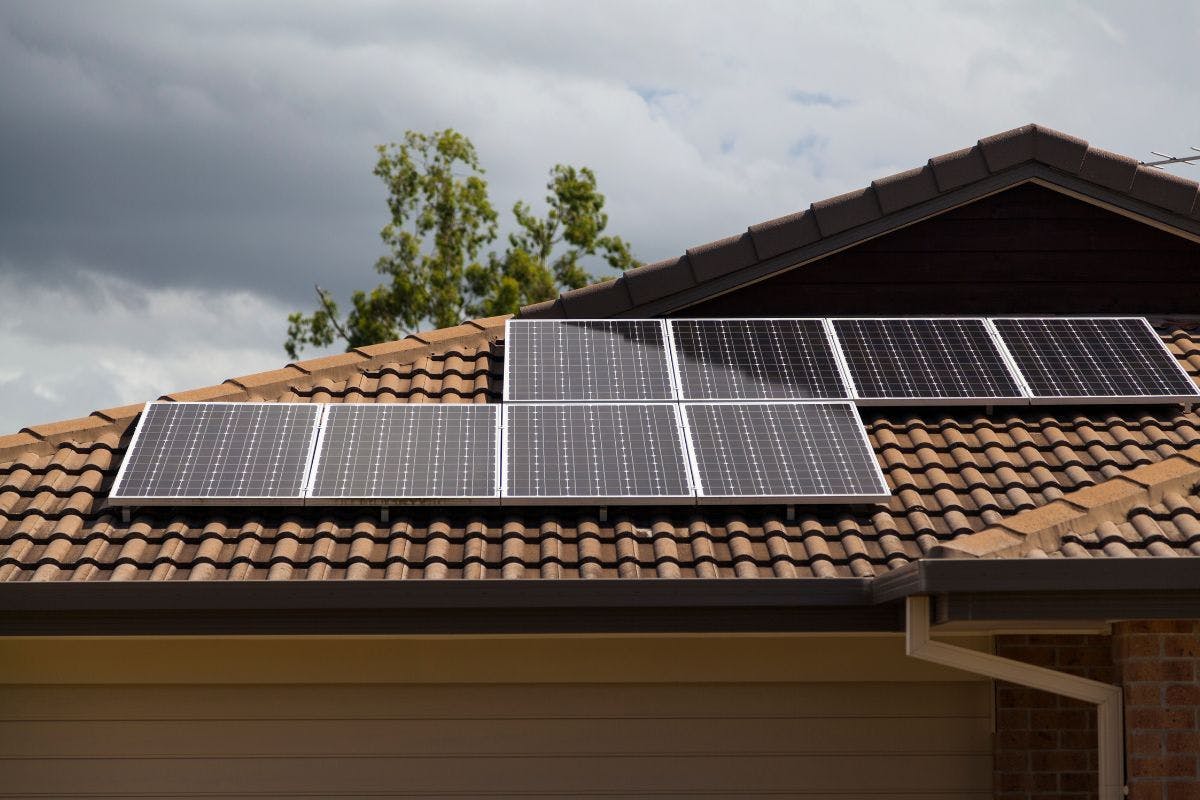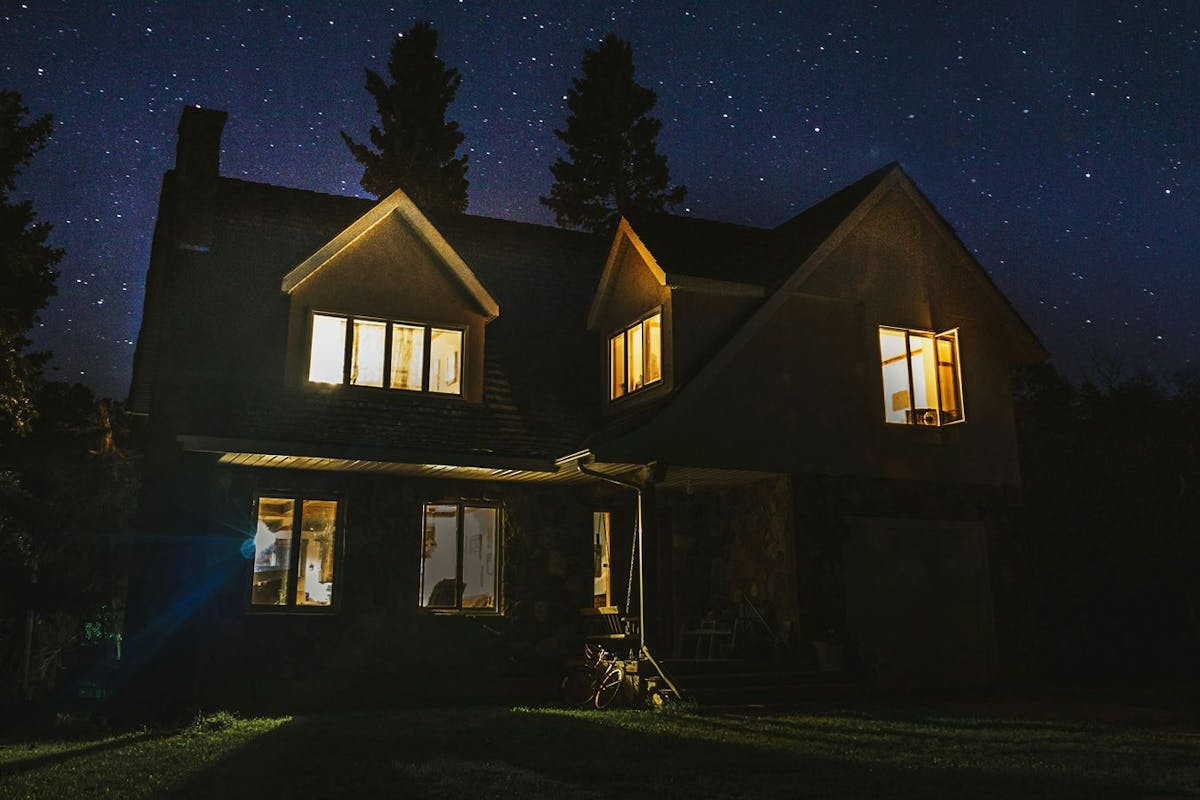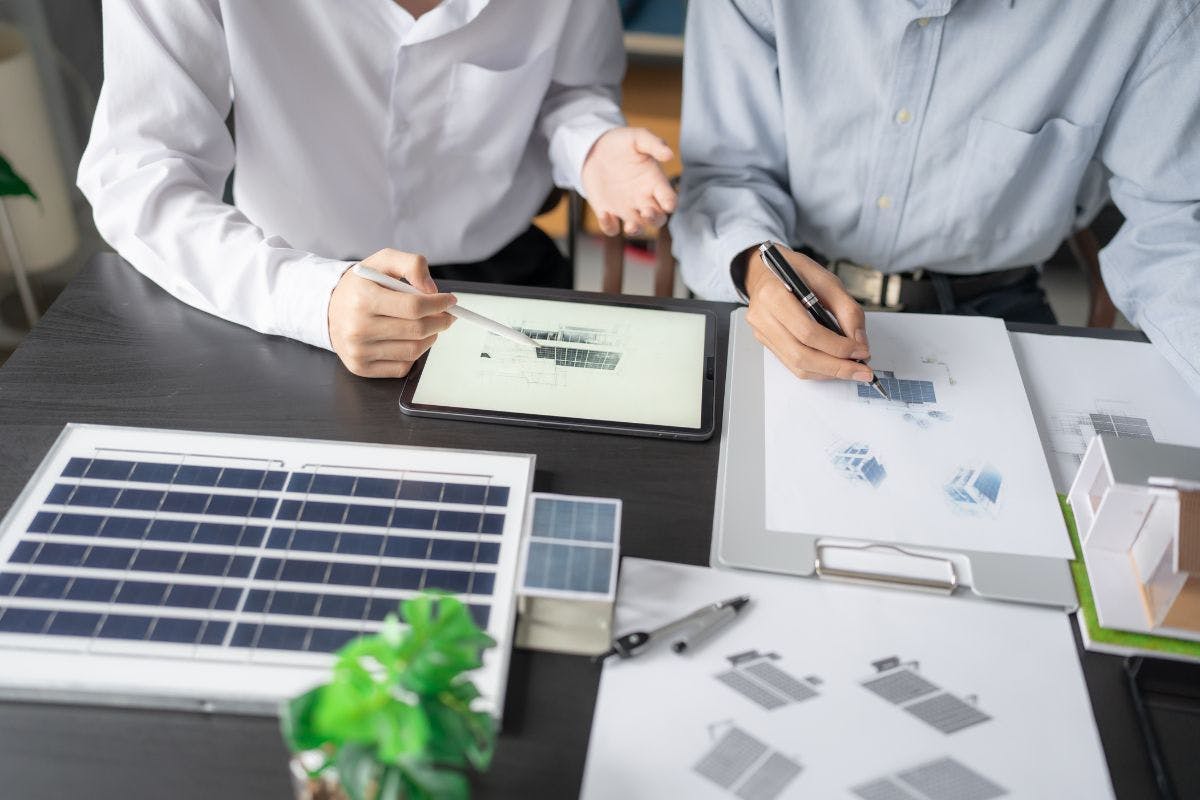How Many Solar Panels Do I Need to Power My Home Appliances?
Last edited

Author
Andrew Giermak
Solar and Electrification Writer and Editor

Editor
Ryan Barnett
SVP, Policy & New Market Development

Energy prices are on the climb, but home solar panels could help you save. Correctly sizing your solar panel system can save you from paying too much for an oversized system and maximize your savings.
A reputable solar installer will help you do this, but you can get an idea of how many solar panels you need by calculating how much electricity your appliances use. Here's how you can estimate how many solar panels your home needs.
See how much you can save by going solar with Palmetto
How to Calculate the Electricity Usage of Household Appliances
To learn how much total power you need for your home, you can start by calculating the amount of power each appliance uses — especially the major ones — and add the numbers together.
Power consumption is calculated in kilowatt-hours (kWh), and it varies by device size, type, and time in use (among other factors). There are two basic ways you can determine how much power each appliance needs.
Use the power rating
- Check the power rating near the power cord. The number is typically listed as amps or watts.
- If the power rating is listed in amps and you know the voltage of the circuit (usually 120) you can use the formula: amps x volts = watts (W).
- Multiply the appliance's wattage by the number of hours the device is expected to operate per day, and then divide the result by 1,000 to find kilowatt-hours/day.
- For example, if you ignore standby mode, your 65” TV screen might consume around 95 watts per hour and run for 4 hours per day: 95 watts x 4 hours = 380 watt-hours/day (or 0.38 kilowatt-hours/day.
Use the consumption
- If your device doesn’t list its power rating, you can also track an appliance's consumption over time using a tracking monitor, such as a smart plug or energy monitor.
- Multiply the energy consumption by the expected operating hours.
How Many Solar Panels Does My Home Need?
The number of solar panels you need to power your home appliances effectively will depend on your consumption habits and the number of peak sun hours your home receives. Typically speaking, the more energy you use, the more solar power you need.
The opposite is true for peak sun hours. If you are in an area with a high number of average hours of sunlight, each solar panel will receive more light, and thus produce more power, so you may need fewer panels to power your home.
To estimate the number of solar panels you need, look at three variables: Solar panel rating, production ratio, and annual electricity usage.
- Solar panel rating: The electricity (power output) generated by a solar panel when the weather conditions are ideal, measured in watts (W). For the calculations below, we use 400 watts as an average solar panel rating of the power solar panels produce.
- Production ratio: The ratio between the estimated energy production of the system over time (kWh) and the actual size of the system (W). Since this number can fluctuate based upon the peak solar hours a region receives, we recommend doing calculations with the range of 1.3 to 1.6.
- Annual electricity usage: The amount of electricity you use to power your home over the course of a year, measured in kilowatt-hours (kWh). This is determined by the energy consumption of your devices and their frequency of use.
According to the US Energy Information Administration (EIA), the average American home used 10,791 kWh of electricity in 2022.
To estimate the number of solar panels the average American homeowner will need, we can use the values listed above with the formula:
Annual electricity usage / Solar panel production ratio / Solar panel rating = Solar panels
- 10,791 kW / 1.3 / 400 W = 21 panels (for areas with fewer peak sun hours)
- 10,791 kW / 1.6 / 400 W = 17 panels (for areas with more peak sun hours)
See what solar can do for you:
How Many Solar Panels Do I Need for Typical Home Appliances?
While the above example provides an estimate based on your whole home’s energy consumption, it doesn’t account for individual appliances.
To break down our investigation further, we’ll examine how many panels each appliance typically needs on its own, and we’ll organize the information by room, average annual power consumption, and duration of use. For each estimate, we will divide annual consumption by 400 W (one of the more common sizes of solar panel installed by Palmetto) to calculate the number of panels needed.
Kitchen appliances
The kitchen is the heart of the home, and it’s often the place where high-usage appliances like a refrigerator, dishwasher, and oven are located. Here is a table of the energy consumption of typical kitchen appliances.
| Appliance | Capacity | Annual hours | Annual consumption | Panels |
|---|---|---|---|---|
| Refrigerator | 150 - 800 W | $8,760.00 | 1,314 - 7,008 kWh | 3.5 - 17.5 |
| Oven | 2,000 - 5,000 W | $150.00 | 300 - 750 kWh | 1 - 2 |
| Stove | 1,000 - 5,000 W | $150.00 | 150 - 750 kWh | 0.5 - 2 |
| Dishwasher | 1,200 - 1,800 W | $260.00 | 312 - 468 kWh | 1 - 1.5 |
| Microwave | 600 - 1,500 W | 78 | 47 - 117 kWh | <1 |
| Coffee maker | 500 - 1,000 W | 60 | 30 - 60 kWh | <1 |
| Toaster | 750 - 1,200 W | 36.5 | 29 - 43.8 kWh | <1 |
| Stove hood | 70 - 150 W | 150 | 10.5 - 22.5 kWh | <1 |
| Blender | 200 W | 73 | 14.6 kWh | <1 |
Bathroom appliances
Here is a table of the annual energy consumption of common bathroom appliances.
| Appliance | Capacity | Annual hours | Annual consumption | Panels |
|---|---|---|---|---|
| Blow dryer | 1,500 - 2,000 W | $182.50 | 274 - 365 kWh | 1 |
| Ceiling fan | 25 W | $3,285.00 | 82 kWh | <1 |
| Electric razor | 15 W | $52.00 | 0.78 kWh | <1 |
| Iron | 750 - 1,100 W | $52.00 | 39 - 57 kWh | <1 |
Living room appliances
The living room is usually filled with several small electronic devices. While they might not use much electricity on their own, they can collectively use a lot of energy.
| Appliance | Capacity | Annual hours | Annual consumption | Panels |
|---|---|---|---|---|
| LCD TV | 50 - 200 W | $1,460.00 | 73 - 292 kWh | <1 |
| LED TV | 20 - 60 W | $1,460.00 | 29 - 88 kWh | <1 |
| Game console | 50 - 200 W | $400.00 | 20 - 80 kWh | <1 |
| Stereo | 40 W | $1,460.00 | 58 kWh | <1 |
| LED bulb | 12 W | 1,825 | 22 kWh | <1 |
| Vacuum | 650 - 800 W | 104 | 68 - 83 kWh | <1 |
The big-ticket items
When it comes to powering your home, many of the appliances that consume the most energy are those that we use every day, but don’t tend to think about as much.
| Appliance | Capacity | Annual Hours | Annual Consumption | Panels |
|---|---|---|---|---|
| HVAC | 3,000 - 3,500 W | $1,825.00 | 5,475 - 6,388 kWh | 14 - 16 |
| Water heater | 4,000 W | $1,095.00 | 4,380 kWh | 11 |
| Window AC | 1,000 - 1,500 W | $1,825.00 | 1,825 - 2,738 kWh | 5 - 7 |
| Washing machine | 400 - 2,500 W | $208.00 | 83 - 520 kWh | <1 - 1.5 |
| Dryer | 1,500 - 5,000 W | 104 | 156 - 520 kWh | <1 - 1.5 |
Tips to Minimize Your Power Consumption
Keep in mind the numbers listed above are just ranges or averages. For example, a 75” big screen is going to use a lot more power than a 32” TV! And the amount of energy it takes to run a refrigerator is going to be a lot different for a giant side-by-side compared to the average refrigerator.
The amount of time many of these devices are used by the typical household varies, so try to take into account your own behaviors when making these calculations.
If you’re adding up the number of panels you might need, and the number is higher than you expected, there are ways you can cut your consumption so you can power your home with a smaller residential solar power system and a smaller solar array.
Here are some easy ways to reduce your energy usage, to help power more of your home with solar power:
- Purchase Energy Star-rated appliances for the most energy-efficient options. (Some may even qualify for an additional tax credit!)
- Turn off lights and water when not in use.
- Plug electronics and chargers into power strips when possible, and turn off the power strip when devices aren’t in use.
- Run energy-hungry appliances during the day in the winter, and at night during the summer.
- Switch all possible light bulbs to LED technology, and save even more money with smart bulbs.
- Run the washing machine on full loads and use cold water.
- Keep your fridge at 3/4 full, but never overload it.
- Use your oven and stove as infrequently as possible, and opt for smaller, more energy-efficient appliances like microwaves and slow cookers.
- Install a smart thermostat so your HVAC system works more efficiently.
- Fix air leaks in your home by installing fresh weatherstripping and caulk around door and window frames.
For more tips, check out 6 Tips For Saving Energy (And Money!) Every Month.
How to Power Home Appliances With Solar
By calculating the estimated power consumption of your home appliances, you can estimate the number of solar panels you need to power your home with clean, renewable energy. You can also review your past utility bills to determine your home's expected power consumption, and use it to gauge the amount of solar energy you might need.
Note: If you are planning to buy an electric vehicle, central air conditioner system, or heated swimming pool within a few years after installing your solar panel system, you should include their expected power usage when calculating your power needs with your solar installer.
Visit our Solar Energy System Calculator to see the recommended system size for your home, and learn how much you can save by switching to home solar. Expert advisors are ready to help you design the best system for your needs.
Frequently Asked Questions
How do I calculate how many solar panels I need for my house?
The easy answer? Call Palmetto. If that’s not right for you at the moment, you can take a power bill and see the average annual consumption for your house. Take the annual number of kilowatt-hours (kWh) and divide it by 400, one of the more common sizes of solar panel installed by Palmetto, and you should get a number in the neighborhood of 20-25 for most homes.
Will solar panels power my house during an outage?
If your home solar system is connected to the main utility company grid, which most are, and you don’t have a battery your power will go out during an outage. However, if your system includes backup battery storage, you have some power when the grid goes out.
The amount of energy available for you during an outage depends on several factors:
- The size and production of your solar panels
- The size of the battery installed
- The battery’s state of charge when the outage occurs
- The areas or appliances in your home that are prioritized to receive power when the grid goes down.
What size solar panels do I need to power my house?
The physical size, as in dimensions and weight, of solar panels may matter as far as your array and how it fits on your roof. The wattage of the panels will be the most important figure used to determine the power capacity your home needs. It’s likely that there isn’t only one size that will meet your energy needs, but multiple.


